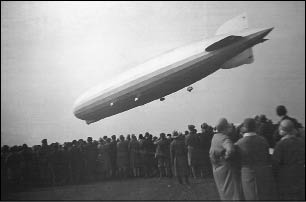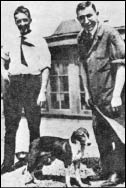Changes
The Great War pushed technological advances ahead at a breakneck pace. After the war the pace slowed, but the 1920s were still a time of dramatic change.
One of the most famous inventions of the time was actually developed too late to be used in the war. The Thompson submachine gun, or Tommy gun, was first offered for sale in 1919 and rapidly became popular with police forces and prohibition gangsters alike.
Zeppelins, lighter-than-air flying machines, were invented in Germany before the war, but used extensively for bombing raids on Britain and France. After the war, Versailles banned Zeppelins in Germany. But the ruling was eventually relaxed and in 1929 the Graf Zeppelin circumnavigated the world in just over 21 days.

The LZ 127 Graf Zeppelin.
Photo by Alexander Cohrs, 1930. Licensed under the Creative Commons Attribution Share Alike 3.0 Unported Licence.

Frederick Banting (right) and Charles Best (left), the discoverers of insulin.
Library and Archives Canada, C-001350.
Although people had been working on transmitting pictures electronically, Scottish inventor John Logie Baird demonstrated the first television in 1926. The following year, he developed the first video recording system. The 1920s also saw the first Technicolor movies.
Aircraft had developed radically during the war and this continued with the introduction of mail delivery flights and passenger transport. The first non-stop crossing of the Atlantic was completed as early as 1919 by John Alcock and Arthur Whitten Brown in a Vickers Vimy bomber. Other firsts followed in quick succession, including Charles Lindbergh’s first solo crossing in 1927.
Many of the new inventions of the interwar years, like the Tommy gun, had violent uses. However, the greatest discovery of the time could be used only for good, and it was Canadian. In 1922 Frederick Banting and Charles Best discovered insulin, enabling the first effective treatment for diabetes. The following year, Banting and J.J.R. Macleod, in whose lab at the University of Toronto Banting worked, were awarded the Nobel Prize for Medicine. Banting thought this unfair and gave half his prize money to his assistant, Best.